for the future selling of steins on auction sites such as eBay, etc. My web site was really started as an informational site for beginning beer stein collectors that would be looking for the info and not the general public. This
STILL =
Nautilus cup – An older type of drinking vessel that has as it main core the shell of a Nautilus. Usually found with silver mounts, some gilded. These were made for display and some are very large and ornate, also valuable.
Naval – non reservists – ▼ shown Kaiser Wilhelm as a naval officer. Relief with a nice paint job.
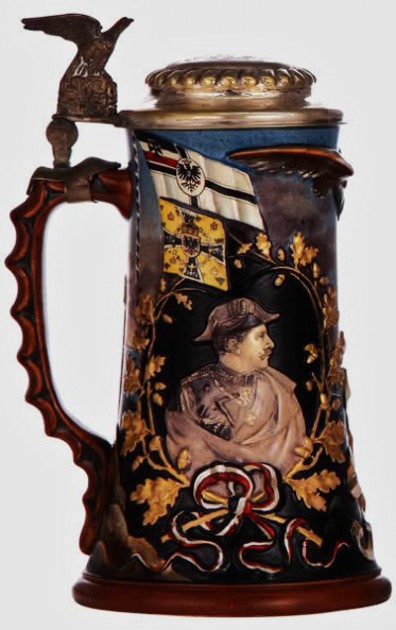
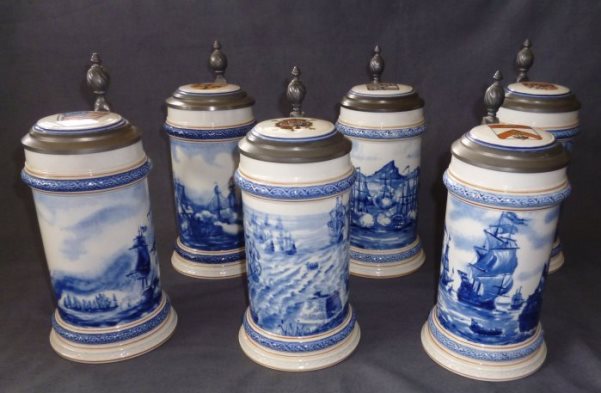 .
. 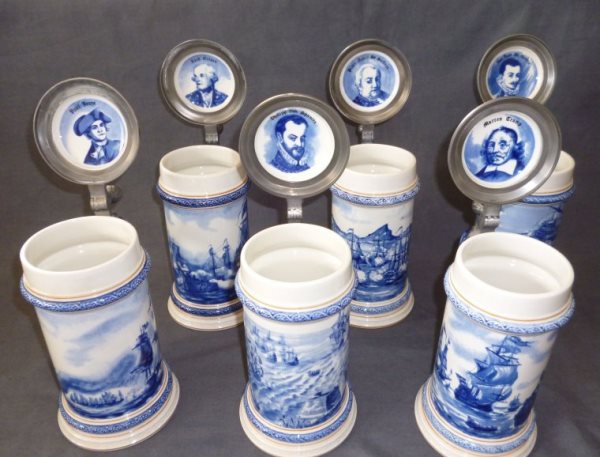 Naval Battles, Famous – The series,-A group of six newer but fairly well done steins by V & B Mettlach when the were trying to enter the USA’s limited edition phase of collecting that went rampant about 30 to 35 years ago (The Age of the Hummels!)
Naval Battles, Famous – The series,-A group of six newer but fairly well done steins by V & B Mettlach when the were trying to enter the USA’s limited edition phase of collecting that went rampant about 30 to 35 years ago (The Age of the Hummels!)
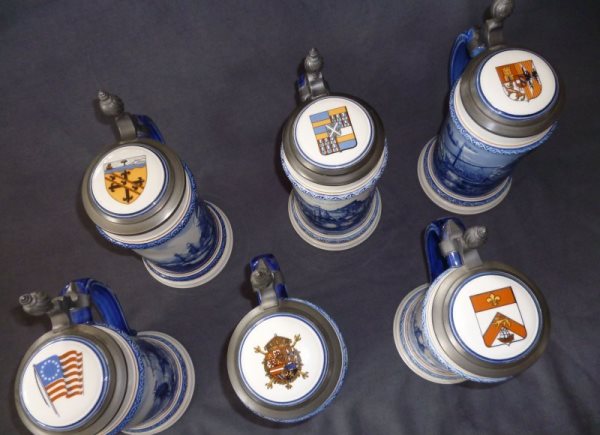
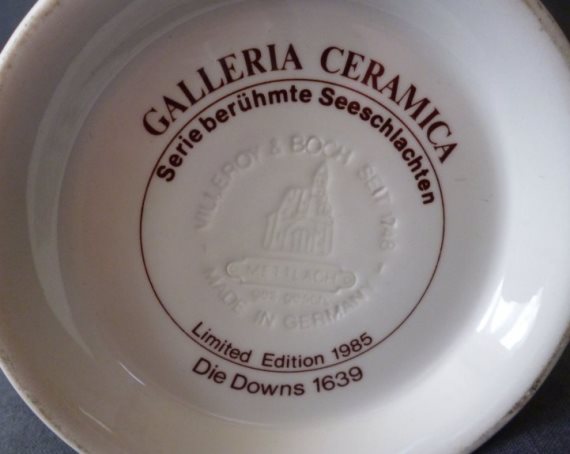 Marks on this series.
Marks on this series.
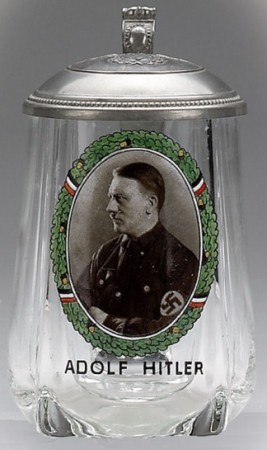
Nazi steins (etc.) – I believe the VAST majority of the 1/2 liter pottery ones with the swastika were made within the last 35 years, mostly for the German and American Nazis fans (or is fanatics? There are original ones out there on the market and it behooves one to buy from trusted auctioneers, who will refund your money if not satisfied. That just about never happens on an eBay sale. When I was writing articles for the magazine “The Classic Collector,” (the Magazine) was partly owned by the USA’s largest gun exporter and importer of all sorts of military crap from around the world,; “Interarmco.” In their warehouse in Alexandria, they had about 1000 [+] reproduction Nazi steins – all brightly “Swastika-ed” (new word?) and labeled with military units – for export to gun shops all around the USA. I see them all the time in the USA auctions now. For more on “Interarmco” see: http://en.wikipedia.org/wiki/Samuel_Cummings and photo at: http://images.gmu.edu/luna/servlet/detail/GMUDPSdps~15~15~12047~100517:Workers-from-Interarmco-in-the-comp Glass steins such as above with Hitler’s photo are fakes and not reproductions as there never were any real ones! Anyone who buys one of these, especially with the story that some American GI originally found it in an German attic after the war was over, and believes that, well “join the club” as there are lots of you out there. The biggest way to spot a fake Nazi Stein is to look at the pewter lid. If it is still shinny on the outside save your money -WWII was 70 years ago -pewter would oxidized a lot in 50 years, and of course, if used would have small nicks, (best seen under a mag glass) around the edge of the rim. The newest version of these fakes don’t have any red stripping on the bottom and the lids have alternating bright and then stained black sections. Shown above▲: The most recent addition to a big crop of Nazi fake steins. To make matters worse it was recently sold at an auction as being authentic! The pewter lid to the stein above is almost so bright one could shave off it!
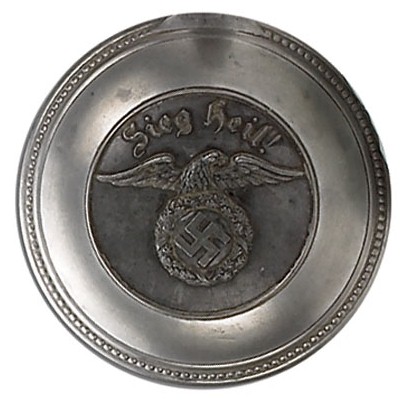
Detail of lid. The pewter lid to the stein above is almost so bright one could shave off it! Most stein body views / main scenes are now taken from old photos and reproduced by a new photo process, the same as the new Pre -WWI” Regimental” steins {See: http://www.steveonsteins.com/reservists-regimental-reproductions-1-4] 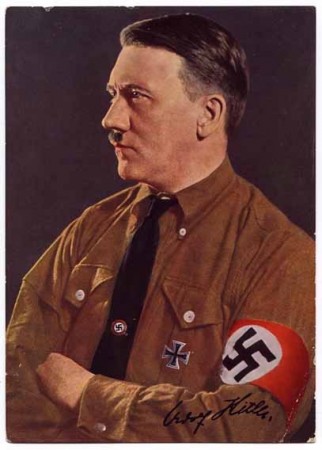 Here is a copy of the photo used for the stein above. Goebbels (the Propaganda Chief) made Adolf Hitler look 15 years younger!
Here is a copy of the photo used for the stein above. Goebbels (the Propaganda Chief) made Adolf Hitler look 15 years younger! 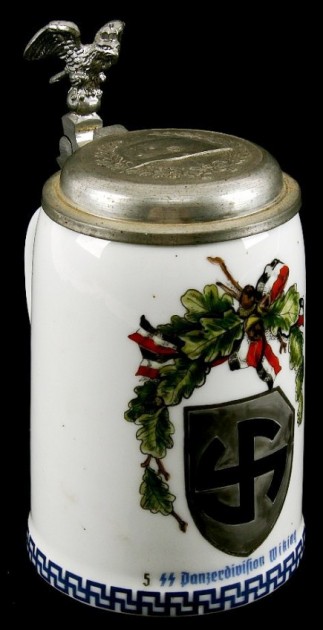
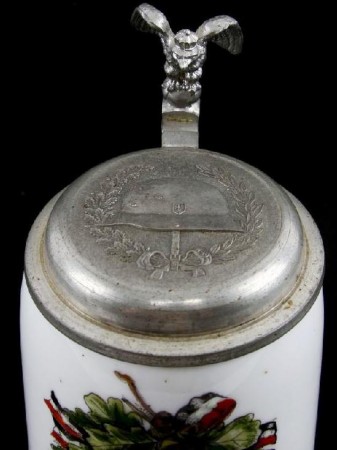 This carries the same lids as seen on all the faked .5 liter pottery steins.
This carries the same lids as seen on all the faked .5 liter pottery steins. 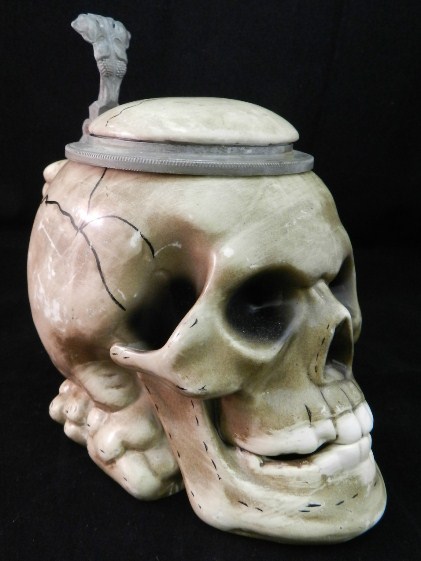
 Another recently seen version: This of an older pottery “skull stein “(see Compendium) that someone had rubber stamped with the SS symbol. Somebody bought it, both figuratively and literally! Oh well. “Caveat emptor!” = “Let the buyer beware! (Or as we beer steiners jokingly say here in Virginia: “The emperor (Kaiser) eats caviar!”
Another recently seen version: This of an older pottery “skull stein “(see Compendium) that someone had rubber stamped with the SS symbol. Somebody bought it, both figuratively and literally! Oh well. “Caveat emptor!” = “Let the buyer beware! (Or as we beer steiners jokingly say here in Virginia: “The emperor (Kaiser) eats caviar!” 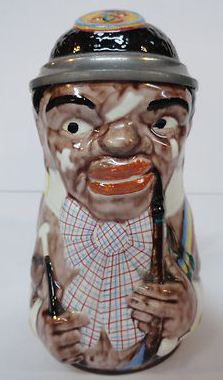
Negro steins (Black person steins) – Not too many were produced but the idea of Negroes on steins during the late 1800’s was USUALLY not considered AS offensive or as funny as it was here in the USA. The V & B Mettlach PUG stein No. 1909 /979 is an exception! (See far below) Shown above: .5 liter porcelain Black man student. A fraternity member. Marked ‘Musterschutz.’ I refuse to use the words “African-American” as it is a total misnomer, and just plain stupid! What have two continents have to do with skin color and bodily features? Nothing ! I had a very attractive white female friend who had been born in the country of South Africa, migrated to the USA when she was about twenty. She used to introduce herself as an African-American, and it was true! I loved it. Also try calling an Egyptian an African-American and then you had better duck or run! 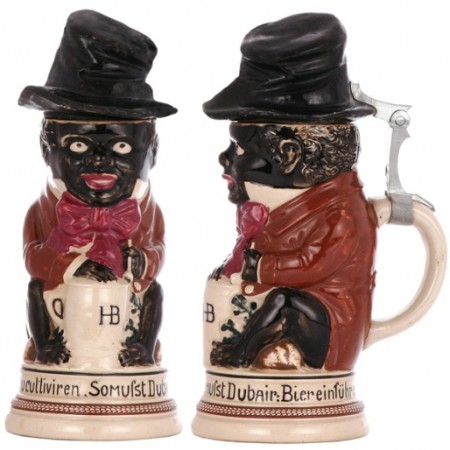 Character stein, .5L, pottery, marked 737. Notice the lid has to double as the thumblift too. [tsaco] .
Character stein, .5L, pottery, marked 737. Notice the lid has to double as the thumblift too. [tsaco] . 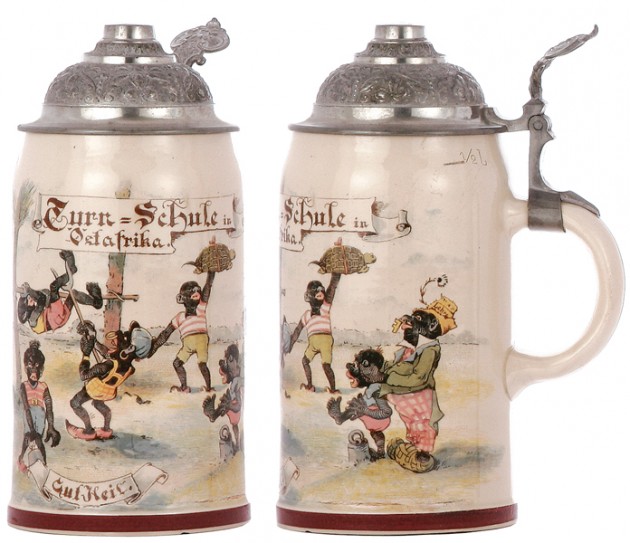 V & B Mettlach No 1909 / 979.
V & B Mettlach No 1909 / 979.  BLACK PERSON STEIN = NOT ! –These steins now mostly sold on eBay, etc., as a black man (African); This emblem is considered a moor, and was part of the family that owned the brewery’s official coat of arms.
BLACK PERSON STEIN = NOT ! –These steins now mostly sold on eBay, etc., as a black man (African); This emblem is considered a moor, and was part of the family that owned the brewery’s official coat of arms. 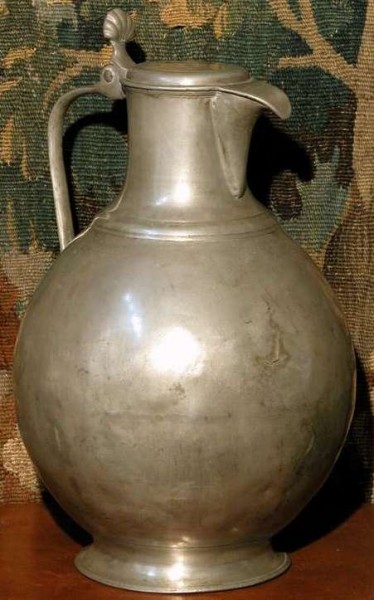 Netherlandish – Drinking vessels made in or very close to the Netherlands, commonly called “Dutch.” Shown: Massive pewter server (flagon) from the ” South Netherlands.” Circa 1760-90.
Netherlandish – Drinking vessels made in or very close to the Netherlands, commonly called “Dutch.” Shown: Massive pewter server (flagon) from the ” South Netherlands.” Circa 1760-90. 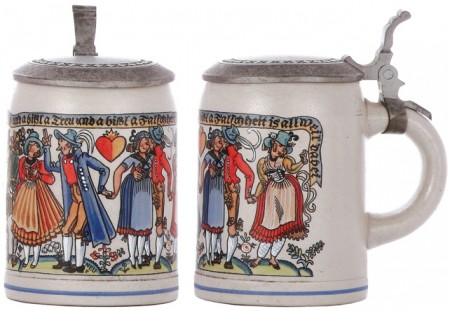 Neu, P. – A German Jugenstil stein scene designer. .5 liter stoneware with PUG scene [tsaco]
Neu, P. – A German Jugenstil stein scene designer. .5 liter stoneware with PUG scene [tsaco] 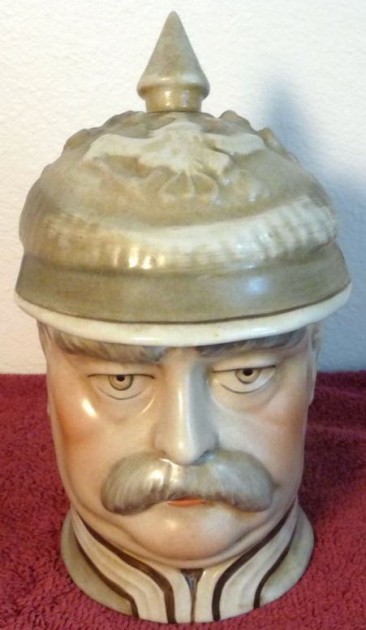
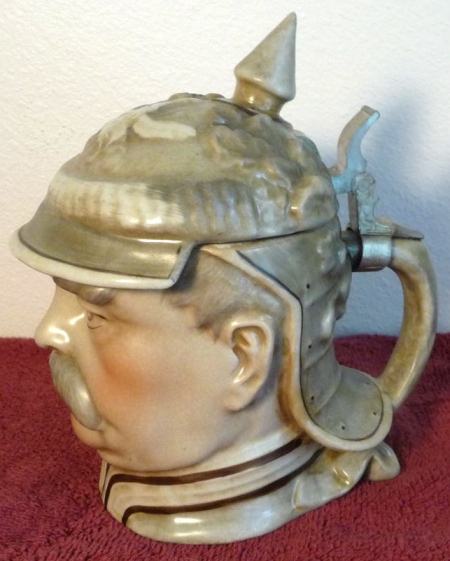 . Neundorf, Germany – Shown: New copy of old Bohn porcelain character stein of Bismarck. First made in 2007. See: http://www.steinmarks.co.uk/pages/pv.asp?p=stein668
. Neundorf, Germany – Shown: New copy of old Bohn porcelain character stein of Bismarck. First made in 2007. See: http://www.steinmarks.co.uk/pages/pv.asp?p=stein668 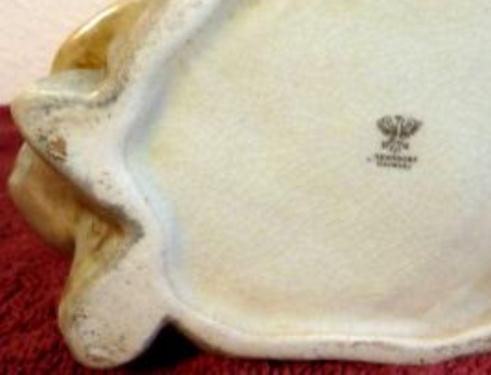 Base and mark
Base and mark
Neuschwanstein (Castle) Germany – The largest and most popular castle of all the ones that Ludwig II of Bavaria built. It was the model for Disneyland’s Magic Kingdom Castle.
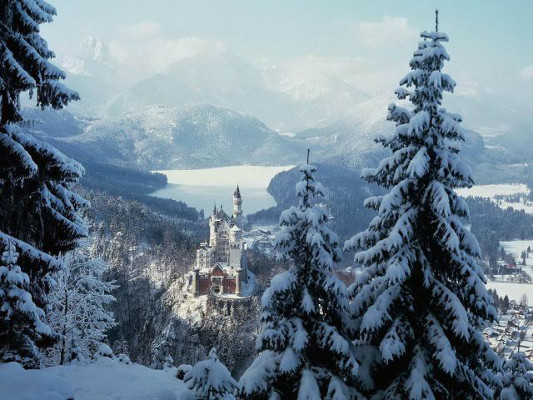
▼ .5 liter porcelain stein. Ca. 1900. Ludwig is shown in the roundel to the left. A Franco -Prussian war era Bavarian Infantryman’s helmet is the finial, called a “caterpillar.” [TSACO]
▼ A very new severely out of proportion “Limited Edition” of the castle in relief. Made by WW team. Great piece, as long as you never wanted to drink a beer out of it!
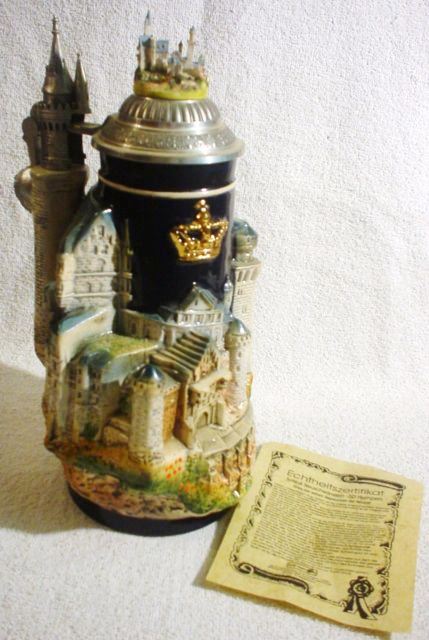
Niche tankards (steins) – Pewter serving steins that have a “niche” or indented platform in the body. Most of these show an occupation of some sorts and the misnomer is to use the word: “Guild Stein.” The majority of these were made by a family of German pewter-smiths whose last name was Weygang, from the mid 1800’s up to at least 1920. Shown: A very scarce “Wine / grape- pressers’ niche tankard” which recently (2010) sold for over $1,000.00 US. See: http://www.steveonsteins.com/future-4-the-famile-weygangs-steins-and-servers
Niemeyer, A. [DESIGNER] R#2205 c.1905 [SA]
![CR- Niemeyer, A. [DESIGNER] R#2205 c.1905 [SA]](http://www.steveonsteins.com/wp-content/uploads/2011/02/CR-Niemeyer-A.-DESIGNER-R2205-c.1905-SA.jpg)
Nickel Silver [“German Silver” ] — Copper-nickel-zinc alloy with a silvery color that is dependent largely on the nickel content which may be between 12 and 25%. Many other terms have been used to describe these alloys such as Argent Anglais, Argentan, “German Silver” and Maillechort. Before WWI it was called “German Silver.”
Niello – A substance that is composed of ground up silver, copper, sulfur and a small amount of lead that is heated and applied to pieces of Russian area Silver (primarily), then buffed to enhance the design. The Egyptians are credited with originating niello decoration, which spread throughout Europe during the late Iron age. Shown: A circa 1930’s Niello enhanced [low grade] silver drinking horn made in Georgia USSR. To be hand held or originally chained to a belt or saddle. 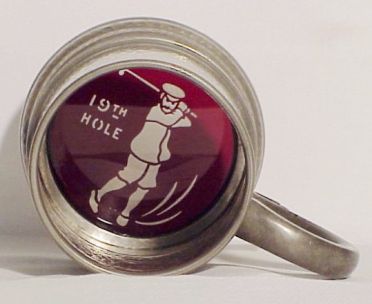 Nineteenth hole – For golfers, the bar in the club house when the course is finished. 90% MARK – The mark stamp on the side of beer stein shank indicating 90% tin used in the lid, and only 10% lead. 95% MARK – The mark stamp on the side of beer stein shank indicating 95% tin used in the lid, and only 5% lead. If either of these marks is on your pewter stein there is a 99% it is new pewter, say within the last 80 to 90 years. Nippon – The old name of the country of the present “whale killers”, (Damn them Japs!) country found on early porcelain ware. Many old mugs are found with that mark, not so with steins.
Nineteenth hole – For golfers, the bar in the club house when the course is finished. 90% MARK – The mark stamp on the side of beer stein shank indicating 90% tin used in the lid, and only 10% lead. 95% MARK – The mark stamp on the side of beer stein shank indicating 95% tin used in the lid, and only 5% lead. If either of these marks is on your pewter stein there is a 99% it is new pewter, say within the last 80 to 90 years. Nippon – The old name of the country of the present “whale killers”, (Damn them Japs!) country found on early porcelain ware. Many old mugs are found with that mark, not so with steins. 
Noggin – The above was advertized on eBay as a “Noggin,” which is a modern day (British English) usage of just a cup or a mug. I think this one at 7 inches tall would be too big to be considered such under the original term as Noggins were a “gill” size and that is a a quarter to half a pint.It might have been better just to call it a “Treen” mug Shown: Late 19th century turned and carved wooden Noggin carve signed by the maker or original owner with the letter A , made from a single piece of walnut. Measures 7 In. high.
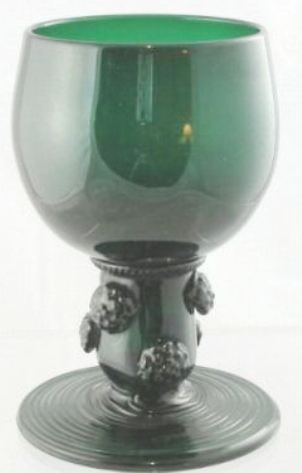
Noppen – German for “Prunt.” Shown: Wald glass roemer “mit noppen.”
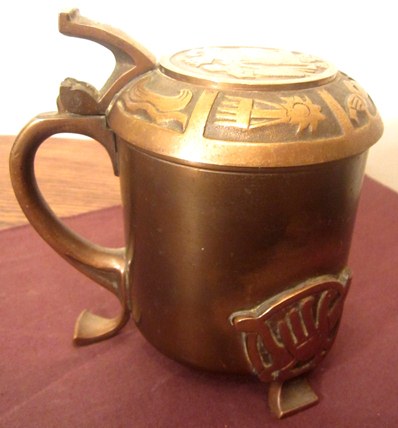 Norge (Norway)– Norwegian steins usually have some sort of feet attached to the bottom of the body. Lions and balls, both plain and enhanced are most predominant. This applies to ones of wood (see just blow as well as pewter and silver. Shown above ▲: A heavy copper Lady’s stein Circa 1950. Marked “Norge” [FWTD] .
Norge (Norway)– Norwegian steins usually have some sort of feet attached to the bottom of the body. Lions and balls, both plain and enhanced are most predominant. This applies to ones of wood (see just blow as well as pewter and silver. Shown above ▲: A heavy copper Lady’s stein Circa 1950. Marked “Norge” [FWTD] . 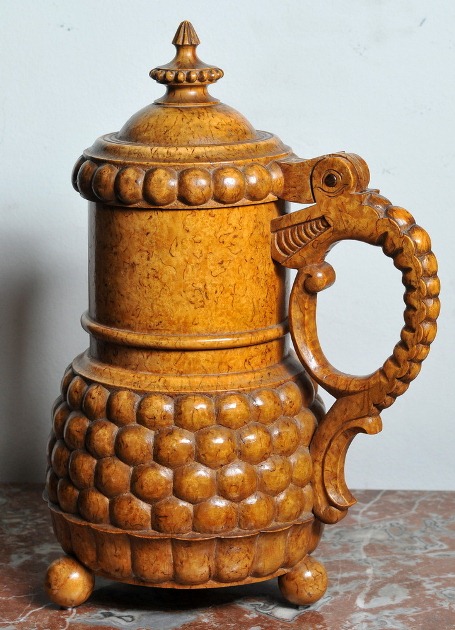 An example of plain ball feet on a turned wood stein Circa 1880. No marks, Baltic States, possibly Norwegian.
An example of plain ball feet on a turned wood stein Circa 1880. No marks, Baltic States, possibly Norwegian.
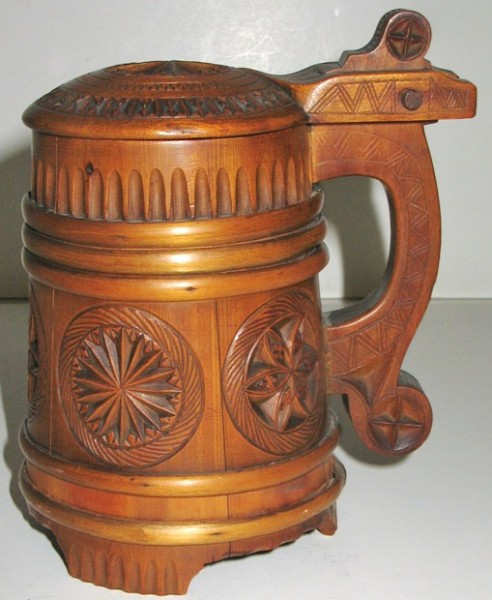 Norwegian wooden steins – Another inadequate term used again and again by the USA stein auctioneers (and other larger firms) for steins made throughout the Baltic Sea region. There are 10 distinct countries that surround the Baltic. They all have great forests. The people there all made wooden steins for hundreds of years! What is now Norway in the 1700’s (when most of these steins listed in the books and catalogs are purported to have been made) was under the control of Denmark. It all makes no sense to me but they continue to this day. I guess it’s easier to do that than to learn the differences. Please see: But will they float? Cork and wood beer steins. [1] for further information and photos. @ http://www.steveonsteins.com/wooden-steins Not a stein – The following photographic examples are sometimes called “beer steins” but in fact are NOT, and never were! Sorry to bust anyone’s bubble!
Norwegian wooden steins – Another inadequate term used again and again by the USA stein auctioneers (and other larger firms) for steins made throughout the Baltic Sea region. There are 10 distinct countries that surround the Baltic. They all have great forests. The people there all made wooden steins for hundreds of years! What is now Norway in the 1700’s (when most of these steins listed in the books and catalogs are purported to have been made) was under the control of Denmark. It all makes no sense to me but they continue to this day. I guess it’s easier to do that than to learn the differences. Please see: But will they float? Cork and wood beer steins. [1] for further information and photos. @ http://www.steveonsteins.com/wooden-steins Not a stein – The following photographic examples are sometimes called “beer steins” but in fact are NOT, and never were! Sorry to bust anyone’s bubble! 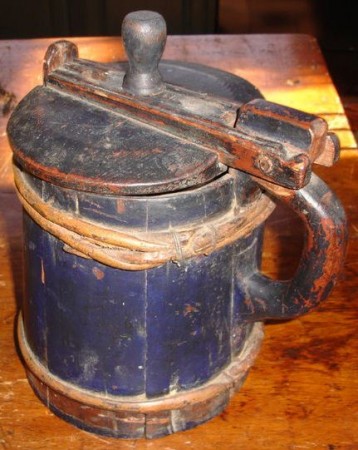
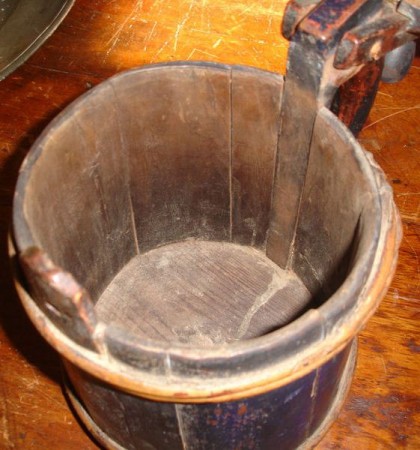 [1] These Scandinavian / Baltic / or US “Pennsylvania Dutch” painted works of wooden art are really grain, berry or mushroom storage containers. The insides never had pitch applied to make them liquid tight and usually they would be way to big to even use full of beer. .
[1] These Scandinavian / Baltic / or US “Pennsylvania Dutch” painted works of wooden art are really grain, berry or mushroom storage containers. The insides never had pitch applied to make them liquid tight and usually they would be way to big to even use full of beer. . 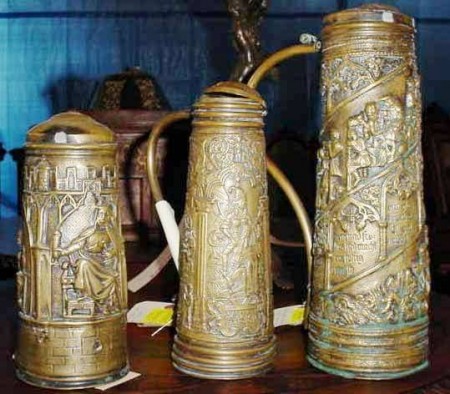 [2] Tinder – ash can steins / fireplace display – These items are not steins at all but display pieces made out of stamped brass. While the scenes were copied from real steins (lots of them V & B Mettlach), the seams do not hold liquid (beer), nor will the base, and if full the larger ones’ handles would rip off! They could be used for storage of anything not heavy, but one of the primarily uses was for tinder next to the fireplaces in late 1800’s European homes; the other for display on a mantle when polished.
[2] Tinder – ash can steins / fireplace display – These items are not steins at all but display pieces made out of stamped brass. While the scenes were copied from real steins (lots of them V & B Mettlach), the seams do not hold liquid (beer), nor will the base, and if full the larger ones’ handles would rip off! They could be used for storage of anything not heavy, but one of the primarily uses was for tinder next to the fireplaces in late 1800’s European homes; the other for display on a mantle when polished. 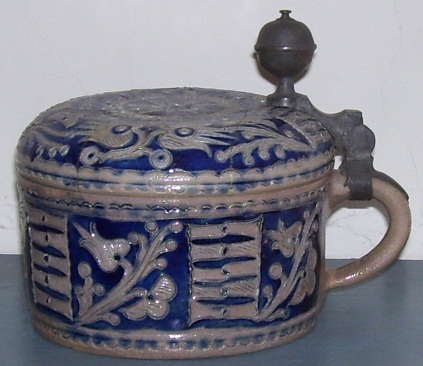 [3] A Westerwald stoneware “butter container.” Ca. late 1700’s, or very early 1800’s.
[3] A Westerwald stoneware “butter container.” Ca. late 1700’s, or very early 1800’s. 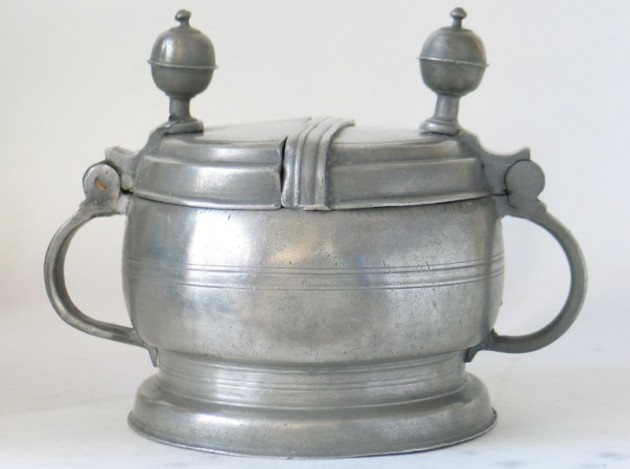 [4] A double handled butter container or just a covered bowl done in pewter. Not a stein and not a tyge! N.S. — Nickel silver. An alloy of nickel, copper and zinc. Before WWI it was called “German Silver.” EPNS = Electro plated nickel silver.
[4] A double handled butter container or just a covered bowl done in pewter. Not a stein and not a tyge! N.S. — Nickel silver. An alloy of nickel, copper and zinc. Before WWI it was called “German Silver.” EPNS = Electro plated nickel silver.
Nude handled steins – Most of these full or upper torso stein handles (which mimic the old style) found will have been produced after WWII ; excluding of course the steins made of true silver from the 1600’s to the present and some of the early porcelain steins. Those had what are called a”Caryatid”as handles. Shown above: A futuristic but not very appealing, half liter German pewter stein. Unknown maker. Circa 1950’s.
NUDE HANDLE MUG -‘ THE ULTIMATE’ 1971 Jim Rumph (1942-1993) SIGNED Mug wITH Headless BUT NUDE — Maiden
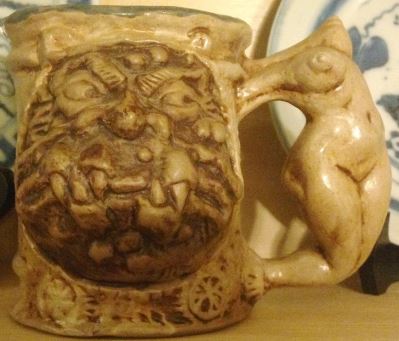
A modern day nude handled ceramic mug by Rumph.
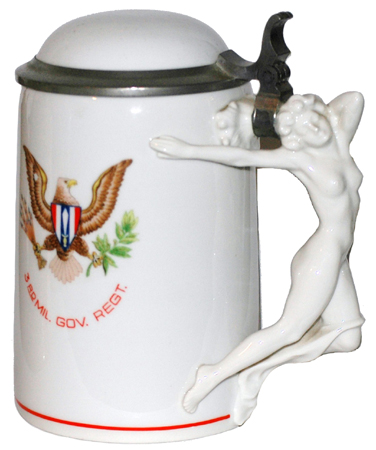
Probably the most common kind of nude handles found. Made to celebrate USA military service overseas. At least the nude is fairly well done! 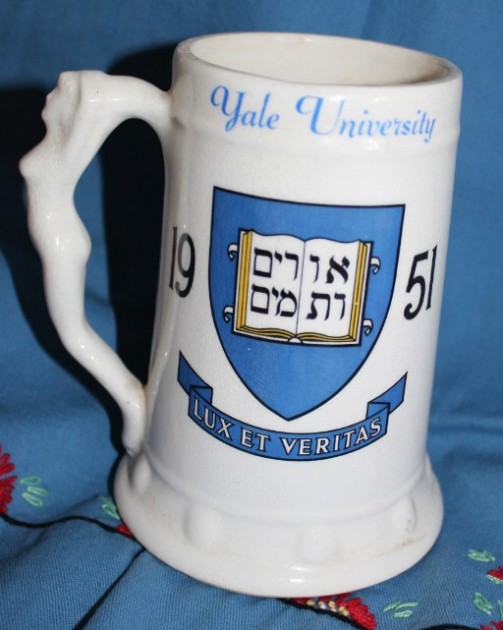 And hell, if the military can have them why not the college kids ? Cheap white painted and glazed pottery made to look like porcelain .
And hell, if the military can have them why not the college kids ? Cheap white painted and glazed pottery made to look like porcelain . 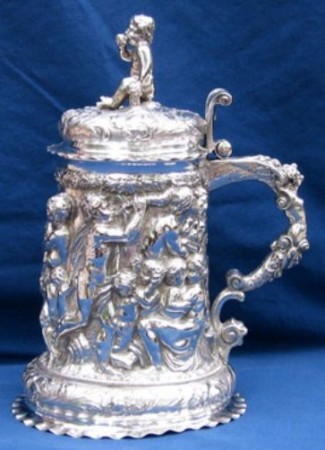
Antique style “Nude’ on handle . This one of .800 silver. It is a copy of the Green Vault’s Ivory stein. “Caryatid” is the name for this form when found on steins. SEE: http://www.steveonsteins.com/silver
Nuremberg / Nurnberg 1712-1840 – City or town of major fayence stein production. For more info, see: http://www.thepatriotexchange.com/pss/hisfai.htm 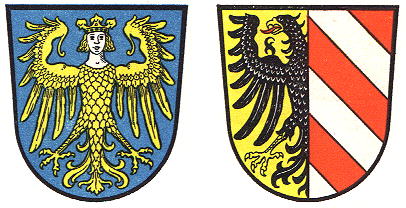 Nuremberg / Nurnberg City Arms – The duel arms of the city. The figure to the left is now referred to as a King with wings. It used to be a “Harpie!” I guess it is more frigging PC not to show female breasts anymore! .
Nuremberg / Nurnberg City Arms – The duel arms of the city. The figure to the left is now referred to as a King with wings. It used to be a “Harpie!” I guess it is more frigging PC not to show female breasts anymore! . 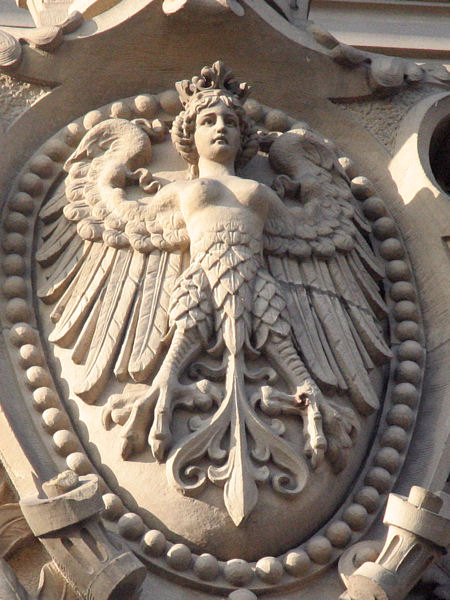 A Harpie, stone carving. Unknown location, sorry.
A Harpie, stone carving. Unknown location, sorry. 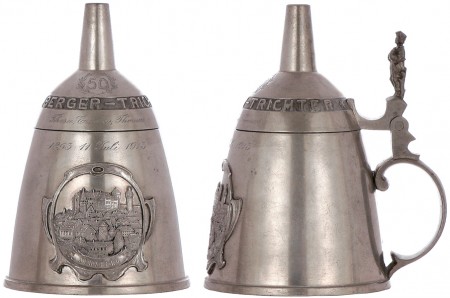
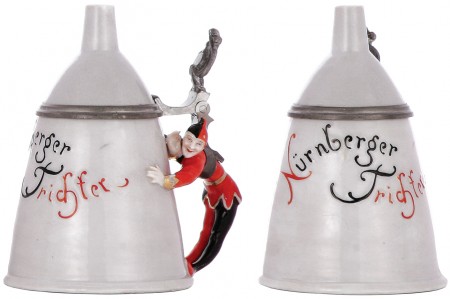
Nuremberg / Nurnberg “trichter” (funnel) – A humorous representation of the Meistersingers’ Judge or the funnel itself. This funnel was needed to pour all the “Laws” that governed Meistersinger’s into the judges’ heads. For more info on this subject, please see: http://www.steveonsteins.com/the-funnel-man-and-its-relationship-to-the-the-minnesingers-and-the-meistersingers
Nurnberg Fayence – Noted for it’s different shades of blues and for religious scenes.
Nuremberg / Nurnberg tower steins – Replica’s of one of the medieval towers on the old city wall. (also called Durer’s tower.) Seen in pottery, pewter, silver and even ivory. Shown ▼: A 5 inch tall saltglazed stoneware stein of the tower. Ca. 1890. Marked TW. Most tower models are of this particular one.
![1 -NURNBERG TOWER STONEWARE - 5 INCHES TW'S [Q] 10-11](http://www.steveonsteins.com/wp-content/uploads/2011/02/1-NURNBERG-TOWER-STONEWARE-5-INCHES-TWS-Q-10-11.jpg)
Nymphenburg – An expensive porcelain stein manufacturer. The firm made some very elaborate hand enameled porcelain steins, but show a lot of the white “china” surface. The one just below is not one of them; ‘elaborate’ that is!
[END – SP104- 59- R5]
 “What if there were no hypothetical questions?”
“What if there were no hypothetical questions?”

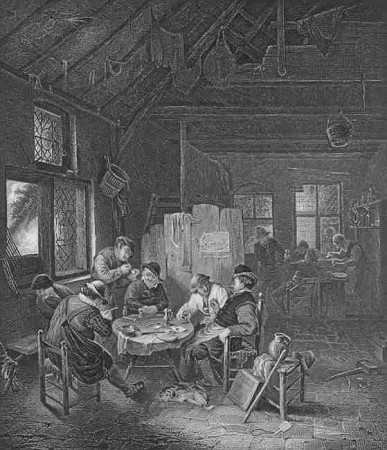
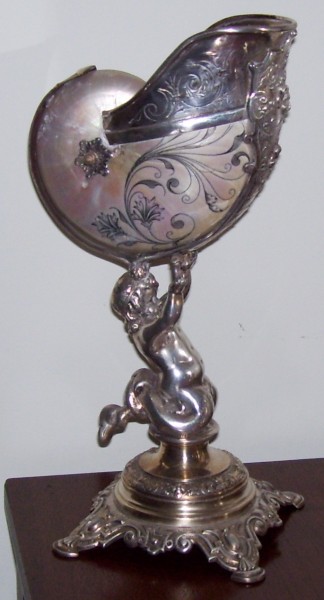
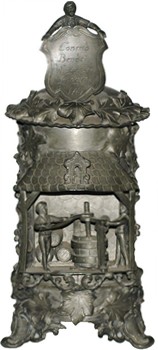
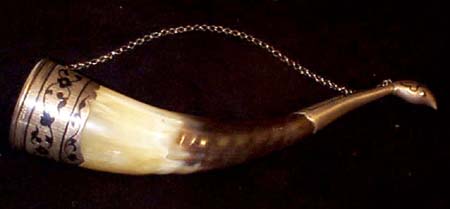
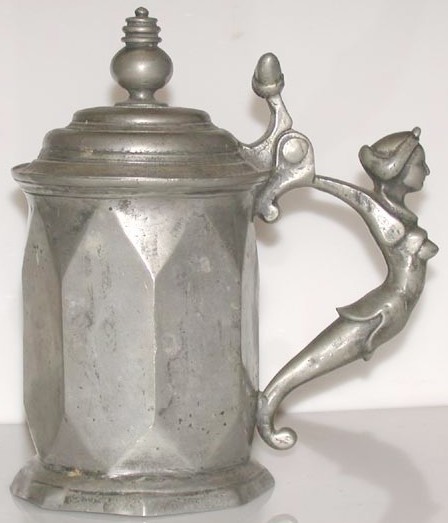
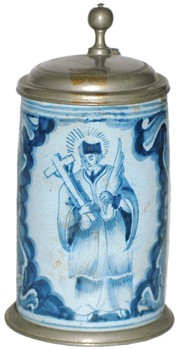
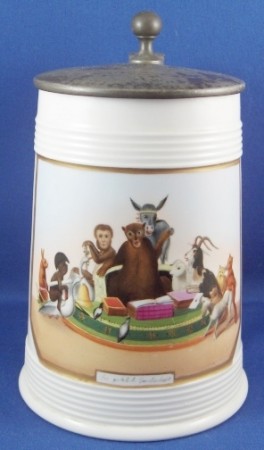
Leave a Reply